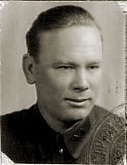Pavel Fitin
Pavel Fitin | |
|---|---|
 NKVD license of Pavel Fitin | |
| Head of the INO | |
| In office May 1939 – May 1946 | |
| Personal details | |
| Born | Pavel Mikhailovich Fitin 28 December 1907 Ozhogino, Yalutorovsky Uyezd, Russian Empire |
| Died | 24 December 1971 (aged 63) Moscow, Russian Soviet Federative Socialist Republic, Soviet Union |
| Awards | Order of the Red Banner Order of the Red Star |
| Signature |  |
| Nickname | Viktor |
| Military service | |
| Allegiance | |
| Branch/service | |
| Years of service | 1932-1953 |
| Rank | Lieutenant General |
| Commands | People's Commissariat for Internal Affairs |
| Battles/wars | |
Pavel Mikhailovich Fitin (Russian: Павел Михайлович Фитин; 28 December 1907 – 24 December 1971) was a Soviet intelligence officer (INO–GUGB–NKVD–NKGB) who was the director of Soviet intelligence during World War II, identified in the Venona cables under the code name "Viktor."[1]
Early life and education
He was born into a Russian peasant family. In 1932 Fitin graduated from the Timiryazev Agricultural Academy, completing the program in agricultural engineering. In 1932-1934 he worked as an editor for the State Publishing House of Agricultural Literature. In 1934-1935 he served in the Red Army. In 1935 he continued his work in the State Publishing House of Agricultural Literature, and in 1936 he was appointed deputy chief editor of this publishing house. In 1938 he passed a training course in foreign intelligence at SHON, the foreign intelligence training school, located in Barvikha, near Moscow.[2]
NKVD Deputy Head
Fitin became deputy chief of the NKVD's foreign intelligence in 1938, then a year later at the age of thirty-one became chief, with the rank of Lieutenant General.[3] The Russian Foreign Intelligence Service credits Fitin with rebuilding the depleted foreign intelligence department after Stalin's Great Purge. Fitin also is credited with providing ample warning of the German invasion (Operation Barbarossa) of 22 June 1941 that began the German-Soviet War.[4] Only the actual invasion saved Fitin from execution for providing the head of the NKVD, Lavrentiy Beria, with information that the General Secretary of the CPSU, Joseph Stalin did not want to believe. Beria retained Fitin as chief of foreign intelligence until the war ended, but demoted him.
Fitin thought it was important to build up a network of spies inside the Manhattan Project. However, at the beginning he was mainly reliant on Klaus Fuchs. Fitin gave the project the codename "Enormoz". In November 1944 he reported: "Despite participation by a large number of scientific organization and workers on the problem of Enormoz in the U.S., mainly known to us by agent data, their cultivation develops poorly. Therefore, the major part of data on the U.S. comes from the station in England. On the basis of information from London station, Moscow Center more than once sent to the New York station a work orientation and sent a ready agent, too (Klaus Fuchs)."[5]
Another important source was John Cairncross. Pavel Fitin reported to Vsevolod Merkulov: "Valuable information on Enormoz is coming from the London station. The first materials on Enormoz were received in late 1941 from our source List (John Cairncross), containing valuable and absolutely secret documents both on the substance of the Enormoz problem and on measures by the British government to organize and develop work on the problem of atomic energy in our country. In connection with American and Canadian work on Enormoz, materials describing the state and progress of work in three countries - England, the U.S., and Canada - are all coming from the London station."[6]
Dishonored Discharge
After Beria was executed in 1953, Fitin was discharged from the NKVD and denied his pension. Fitin was unable to find employment until 1959.
Honors
Fitin attained the rank of lieutenant-general, and was awarded the Order of the Red Banner twice, the Order of the Red Star, the Red Banner of Tuva and Order of the Republic of the Tuvan People's Republic.
Legacy

In 1942, Joseph Stalin appointed Pavel Sudoplatov to head the intelligence work on the Manhattan Project, and to coordinate the data gathered by Soviet agents in England, Canada, and the United States. Most cables sent via the New York – Moscow connection were sent by KGB officer Leonid Kvasnikov, known as Anton, to Lieutenant General Pavel Mikhailovich Fitin, known as Viktor, who had been the head of the foreign intelligence section of the KGB at that time (NSA 2/9/44).
See also
Notes
- ^ Venona 195 New York to Moscow 9 February 1944 Archived 18 September 2013 at the Wayback Machine
- ^ Hastings. Page 123.
- ^ Hastings. Page 123.
- ^ Hastings. Page 131.
- ^ Simkin, John (1 August 2014). "Pavel Fitin". Spartacus Educational. Retrieved 4 May 2017.
- ^ Pavel Fitin report to Vsevolod Merkulov (August, 1945)
References
- Pavel Fitin's Memoirs: Overview of Soviet Intelligence in World War II.
- NSA VENONA PROJECT
- NSA VENONA PROJECT DOCUMENT ON FITIN
- Foreign Intelligence Service bio in Russian.
- Hastings, Max (2015). The Secret War: Spies, Codes and Guerrillas 1939–1945 (Paperback). London: William Collins. ISBN 978-0-00-750374-2.
- John Earl Haynes and Harvey Klehr, Venona: Decoding Soviet Espionage in America (New Haven: Yale University Press, 1999)
- Vladimir Chikov, Stalin’s Atomic Spies: KGB File N. 13676 [Unpublished American Edition of Comment Staline a Volé la Bombe Atomique Aux Américains: Dossier KGB no 13676], trans and afterword by Gary Kern (1995)
External links
- [1] Pavel Fitin
